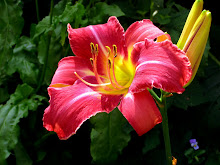
Spring and fall are the seasons for dividing and transplanting, making changes in the garden. I’ve got a big, long list of what to move where, and have been chipping away at it now that the weather has grown cooler.
But there’s a world of difference between having a knack for growing things, and having a talent for garden design. I’m good at the former, not so great at the latter. Despite studying all those books and magazine articles, even the diagrams in seed catalogs that promise you the “perfect” garden, I’m still missing something.
Sometimes, I think it’s disposable income. The “instant” garden that’s put in by a landscape designer begins with a clean slate, and requires a serious cash infusion (not to mention a small army of workers to make it all happen). Have you seen the price tags on those beautiful flowering specimen trees and bushes? Or figured out how much a lovely winding path of peastone or pavers will cost, from excavation to the finished product?
More often, if you’re like me, we look at what we’ve got already and see what improvements we might be able to make on a limited budget – sometimes so limited that it means just moving things around in the hopes the garden will look better, like rearranging our living room furniture. It also requires being able to foretell the future, having a vision of how big that Echinacea or tickseed is going to be when it matures in two or three years … will it be too large for that spot in the garden? And, let’s face it, there’s more to it than just putting the short things in front and the tall things in back, or having a color "theme."
For years I succumbed to the impulse to purchase a pot of one thing or another that I liked, but since I never could afford more than one or two at a time, my gardens were a jumble. Then we moved, and I inherited perennial beds with great swaths of certain flowers, with repeated plantings at intervals, with tall non-flowering accent plants in the background, and I saw what a difference that made. Still, those gardens were typical straight-edged border beds. Now there are some new beds, curvy-edged; works in progress, they are. I’m still learning. But I think it's looking a little better each year.

No comments:
Post a Comment